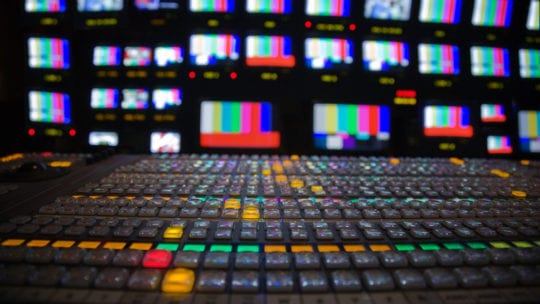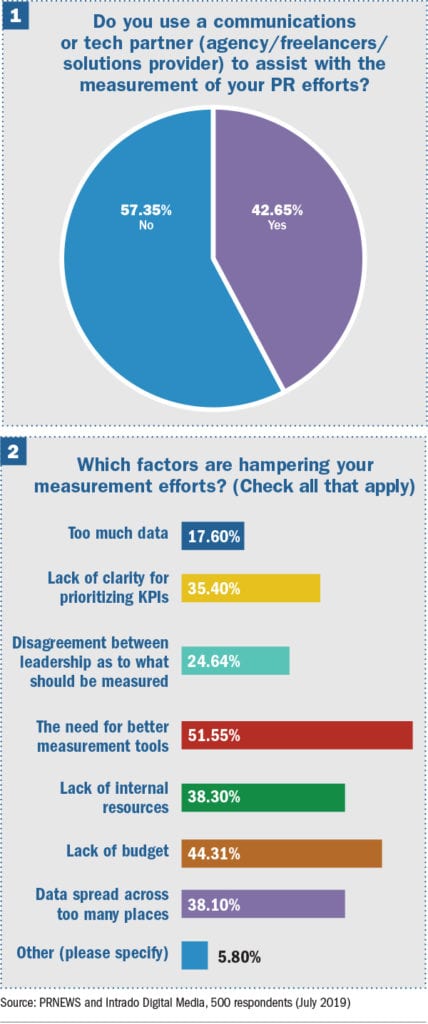
Old habits die hard. What about old ideas? In the digital age, it’s said to be common knowledge that data is overwhelming communicators. Just about everything a communicator does can spew data. With so much data available, a significant question centers on what should be measured and what can be ignored.
Yet look at chart 2, which comes from a survey PRNEWS and partner Intrado Digital Mediacollaborated on during the summer. Asked to identify factors hindering PR measurement, only 18 percent of the 500 communicator-respondents picked “too much data.” So much for conventional wisdom. Or maybe not.
Other choices on the chart indicate indeed there is confusion about measurement priorities. The root of some of that confusion is the massive amount of data.
For example, 35 percent picked “lack of clarity for prioritizing KPIs.” A related response, 25 percent said there’s disagreement within leadership about what to measure. In addition, 38 percent said “data is spread across too many places.” Though none of those responses constitue a majority, they indicate communicators are having significant measurement issues, and a plethora of data is compounding the situation.
Budgets Blamed
Less ambiguous are the budget-related responses. Nearly half (44 percent) pointed to budget issues as a factor hampering measurement. Similarly, 38 percent fingered “lack of internal resources” as the culprit. Chart 1 also has a budgetary interpretation--almost 60 percent of communicators said their companies don’t pay for outside sources to help with measurement. Is that because measurement remains a low-budget priority? Are all those companies performing measurement in-house? Are they using free, native tools?
Back to chart 2, there’s good and bad news for vendors. As you can see, the quality of measurement tools was the major inhibitor of measurement, at 52 percent. That’s good news for vendors, assuming they can create better tools and communicate their improvements. On the other hand, the responses appear to indicate firms are reluctant to spend significantly for measurement tools.
In next month’s PRNEWS, we’ll include an article about the full survey, along with additional analysis from Intrado Digital Media.

FH: Great Products Are Half The Battle
In theory, companies do their best to build outstanding products. Marketers communicate the strengths of those products. There’s more proof that those steps might not be enough to sway consumers to purchase the company’s wares, however.
“Engaged consumers” globally say that the quality of a company’s products and services shape less than half (47 percent) of their beliefs about the company. How a company interacts with society and the way its management behaves shape the rest, according to a FleishmanHillard study of 7,400 “engaged consumers” in Brazil, Canada, China, Germany, the U.K. and the U.S.
But the “2019 Authenticity Gap” study cautions against companies jumping into social issues with abandon. About 30 percent of the population, engaged consumers are most concerned about data security and data privacy (73 percent want protection beyond regulatory mandates), access to affordable and quality healthcare, violence against women and access to affordable and quality education.
Yet the survey also shows consumers are realistic. Consumers know companies can’t fix everything They expect companies to take stands only on a few issues. In particular, issues that they have some control over, such as data privacy/security, protecting the environment, reducing income and wage gaps and issues surrounding the minimum wage. The report can be found in the PRNEWS Resources Center.

Your Story on TV in 2020
Part of the role of measurement is to test assumptions. Surveying is a great way to measure assumptions.
Your company is known for its great customer service, right? Survey your customer base. You might find the customer service of one of your competitors is perceived as far better than yours. Trade shows are the best places to sell your particular products. Again, a survey of your customers might find that buying products at a trade show is far down their priority list.
An apt assumption to test as activity around the 2020 elections begins to heat up is whether or not political stories will crowd out television coverage of nearly everything else. The conventional wisdom says yes. It will be nearly impossible to get your brand story featured on television during the election frenzy.
While it’s true that cable news networks will probably be wall-to-wall politics during the 2020 election cycle (that seems to be the case already, doesn’t it?), local TV news seems to be offering a more balanced news diet these days.
Indeed, results from a D S Simon Media survey of local TV news personnel (July 29-August 9) provided exclusively to PRNEWS, shows locals plan to devote about 26 percent of their morning news programs to political stories during the 2020 election cycle [upper chart].
D S Simon surveyed 101 news directors, managers, producers and reporters at local TV stations via email. Their anonymity was protected.
The reason for the more modest political coverage, says D S Simon chief Doug Simon, is that local news directors realize political junkies will spend a lot of time watching cable news channels during the election cycle. Therefore, local broadcast news is smart to devote only a limited amount of resources to political coverage. This equates to opportunities for brands to get their narrative covered on local news programs, he says.
The bottom chart shows the amount of coverage local nightly newscasts devoted to political stories in the wake of the first presidential debate in July. That debate pitted a bevy of Democrat hopefuls. As you can see, coverage of political stories constituted less than 6 percent of all local network affiliate newscasts in New York, Los Angeles, Milwaukee, Orlando and Austin.
As expected, cable news outlets Fox News, MSNBC and CNN were pretty much non-stop political coverage. The nightly broadcast network newscasts devoted nearly 40 percent of their programs to political coverage. Compared to the nightly broadcast news ratings, the cable news channels are niche operations.
CONTACT: peter.kidd2@west.com dougs@dssimonmedia.com Chelsey.Watts@fleishman.com
